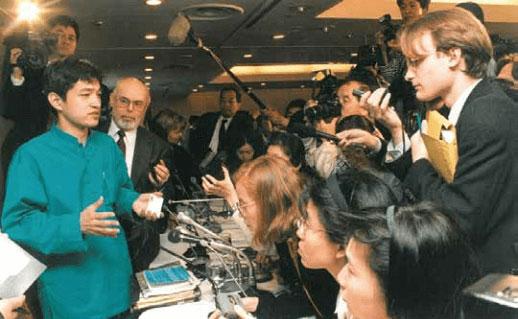Issue:

(AP photo by Tsugufumi Matsumoto)
THE FIRST MAJOR press conference of Aum Shinrikyo (Supreme Truth) drew wide news coverage and was carried live by a number of Japanese TV networks. Joyu was absent from a second news conference held at the Club only days later, on April 7. Instead, lawyer Nobuyoshi Aoyama, and head scientist Hideo Murai, fielded questions. (Murai was stabbed to death in front of Aum headquarters a few weeks later.)
Both events drew criticism from some Club members who viewed them as abetting the spread of Aum propaganda. President Hielscher rejected that view saying that the news conferences presented major news events. The grumbling subsided as Aum continued to make headlines.
A doomsday cult founded by Shoko Asahara (born Chizuo Matsumoto) in 1984, Aum was built on a patchwork of elements drawn from major religions. It was also influenced by a fictional book in which a group of scientists survive a calamity to create a new world. Using this, Asahara lured into his cult the young scientists who later produced the sarin used in the subway attack as well as other chemical and biological weapons.
Intended to divert police attention, the subway attack of 1995 instead led to Aum’s downfall. The cult lost its status as a religious organization shortly thereafter, had assets seized, and had its compound near Mt. Fuji where the sarin gas had been made closed down. Its membership at the time was estimated at some 40,000 members worldwide with over 9,000 members in Japan.
Although sentenced to death by hanging in 2004, Asahara’s execution is still on hold. The last fugitive of the sarin attack, Katsuya Takahashi, was captured in 2012 and will be tried in January, 2015. A verdict is expected in April.
— Charles Pomeroy

